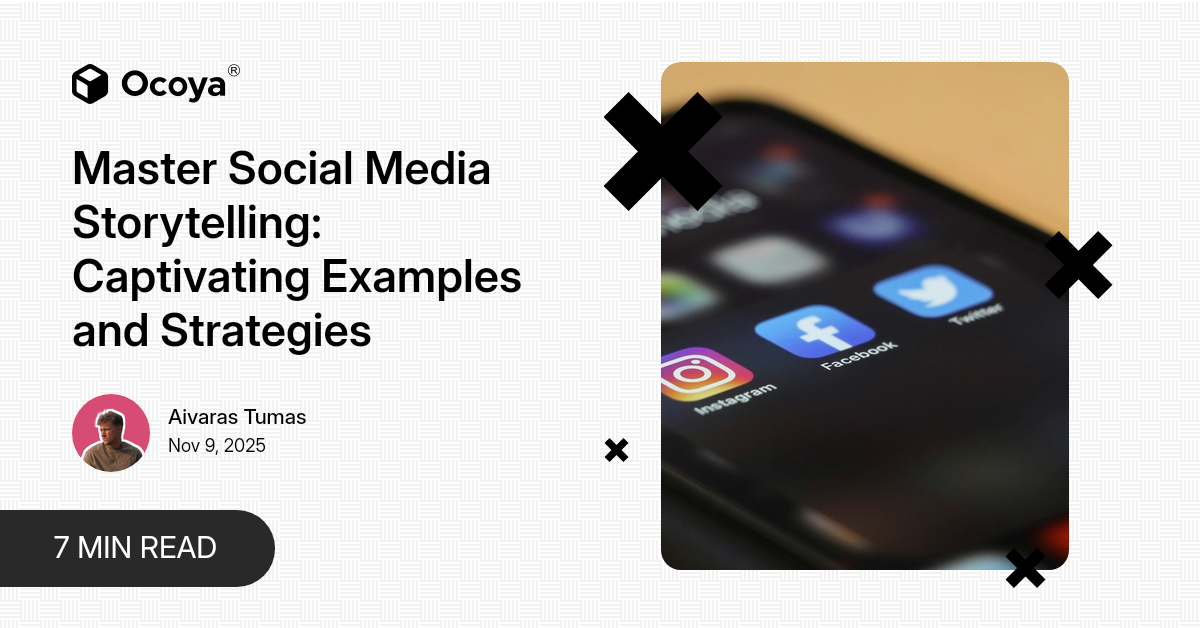
November 9, 2025
Marketing
Master Social Media Storytelling: Captivating Examples and Strategies

Within the vast digital landscape, the art of storytelling has captured the hearts and minds of audiences worldwide. Social media storytelling has become a vital component in engaging and retaining followers, turning mundane scrolls into captivating journeys. In a world where content is king, crafting compelling stories can set your brand apart, foster deeper connections, and ultimately, drive remarkable success.
Mastering social media storytelling requires not only understanding your audience but also employing a blend of creativity, strategy, and authenticity. In this comprehensive guide, we will delve into the intricacies of social media storytelling examples, showcasing proven strategies and inspiring case studies to help you weave narratives that resonate and inspire.
Understanding the Power of Social Media Storytelling
Before diving into specific social media storytelling examples, it’s essential to grasp the underlying power of a well-told story. Humans are inherently drawn to stories because they evoke emotions and create connections. In the context of social media, storytelling serves several crucial purposes:
Engages the Audience: Stories capture attention and keep users engaged longer. Unlike traditional advertisements, which can be perceived as interruptions, stories seamlessly integrate into the user's feed, creating a more immersive experience.
Builds Emotional Connections: A compelling story has the power to evoke emotions, making the audience feel a sense of connection with the brand. These emotional bonds can drive brand loyalty and advocacy.
Enhances Brand Identity: Storytelling allows brands to convey their values, mission, and personality. This distinct brand narrative can differentiate a company in a crowded marketplace.
Simplifies Complex Information: Stories can break down intricate information into digestible, relatable content, making it easier for the audience to understand and remember key messages.
Crafting the Perfect Social Media Story
Creating an impactful social media story involves several key components that must work in harmony to capture and maintain the audience's attention. Here are some essential elements to consider when crafting your narrative:
Know Your Audience
To create a story that resonates, you must deeply understand your target audience's preferences, pain points, and interests. Conduct thorough research to gain insights into their demographics, online behaviors, and content consumption habits. Tailor your stories to align with their values and aspirations.
Define Your Brand's Core Message
What is the central message you want to convey through your story? Whether it’s highlighting a product's unique benefits, showcasing behind-the-scenes moments, or sharing customer success stories, ensure your narrative aligns with your brand's mission and values.
Create a Relatable Protagonist
Every great story has a relatable protagonist, someone the audience can root for. In the context of social media storytelling, your protagonist could be a satisfied customer, a dedicated employee, or even the brand itself. Present your protagonist in a way that elicits empathy and connection.
Incorporate Conflict and Resolution
Conflict is essential in storytelling as it creates tension and keeps the audience invested. Present a challenge or problem that your protagonist faces, and then illustrate how they overcome it. This journey from conflict to resolution is what makes your story compelling and memorable.
Use Visual and Emotional Elements
Visuals play a significant role in social media storytelling. High-quality images, videos, and graphics enhance the narrative and make it more engaging. Coupled with strong emotional elements, such as evocative language and relatable scenarios, your story can leave a lasting impact.
Maintain Consistency
Consistency in storytelling helps build a cohesive brand identity. Whether you're sharing short stories in individual posts or an ongoing series, ensure that your tone, style, and messaging remain consistent. This consistency fosters familiarity and trust with your audience.
Encourage Engagement
Engagement is the lifeblood of social media storytelling. Encourage your audience to interact with your stories by asking questions, inviting comments, and using interactive features like polls or quizzes. Respond to comments and foster conversations to build a sense of community.
Captivating Social Media Storytelling Examples
To inspire your creative process, let's explore some captivating social media storytelling examples that have successfully captivated their audiences:
Airbnb: The World Through the Eyes of Hosts and Guests
Airbnb has mastered the art of social media storytelling by turning the spotlight on their hosts and guests. By sharing authentic stories of unique stays, cultural exchanges, and personal experiences, Airbnb creates a sense of belonging and adventure. Their Instagram account is filled with visually stunning images and heartwarming narratives that transport the audience into the world of their community.
Dove: Real Beauty Campaign
Dove's "Real Beauty" campaign is a powerful example of storytelling that challenges societal norms and spreads a positive message. By featuring real women of diverse shapes, sizes, and backgrounds, Dove's stories celebrate authenticity and self-love. This campaign not only resonates emotionally but also reinforces Dove's commitment to promoting genuine beauty.
Humans of New York: The Humanity in Every Face
Humans of New York (HONY) started as a simple photo blog, capturing the stories of everyday New Yorkers. It has since evolved into a global phenomenon, showcasing the depth and diversity of human experiences. HONY's storytelling approach emphasizes empathy and connection, drawing millions of followers who feel personally moved by each story.
GoPro: The Thrill of Adventure
GoPro's storytelling revolves around the exhilarating adventures of their users. By encouraging customers to share their action-packed footage, GoPro creates a community of thrill-seekers who inspire each other. These user-generated stories not only highlight the product's capabilities but also create a sense of camaraderie and excitement.
Warby Parker: Customer-Centric Narratives
Warby Parker's storytelling strategy focuses on their customers' experiences, from finding the perfect pair of glasses to the impact of their Buy a Pair, Give a Pair program. By sharing customer testimonials, behind-the-scenes glimpses, and philanthropic efforts, Warby Parker fosters a strong emotional connection with their audience.
Strategies for Effective Social Media Storytelling
Now that we've explored some inspiring social media storytelling examples, let's delve into actionable strategies to help you craft and share your own compelling narratives:
Leverage User-Generated Content
User-generated content (UGC) is a treasure trove of authentic stories. Encourage your customers to share their experiences with your brand through photos, videos, and testimonials. Repost their content on your social media platforms, giving credit to the original creators. UGC not only provides genuine social proof but also strengthens your brand's credibility and community spirit.
Utilize Instagram Stories and Reels
Instagram Stories and Reels are powerful tools for storytelling due to their ephemeral nature and interactive features. Use these formats to share behind-the-scenes glimpses, tutorials, user stories, and real-time updates. The creative potential of Stories and Reels allows you to experiment with different content styles and formats.
Collaborate with Influencers
Partnering with influencers can amplify your social media storytelling efforts. Influencers bring their unique perspective and established following, making your stories more relatable and impactful. Choose influencers whose values align with your brand and collaborate on content that authentically tells your brand's story.
Create Episodic Content
Episodic content keeps your audience coming back for more. Develop a series of interconnected stories that unfold over time, creating anticipation and engagement. Whether it's a weekly vlog, a monthly behind-the-scenes look, or a customer success series, episodic content can establish a loyal and invested audience.
Tell Stories Across Multiple Platforms
Different social media platforms offer unique opportunities for storytelling. Tailor your stories to fit the strengths of each platform while maintaining a consistent narrative. For instance, use Instagram for visually-driven stories, Twitter for concise and impactful messages, and LinkedIn for professional insights and thought leadership.
Monitor Performance and Adapt
Regularly monitor the performance of your storytelling efforts using social media analytics. Track metrics such as engagement rates, reach, shares, and comments to understand what resonates with your audience. Use these insights to refine your storytelling strategy and optimize your content for better results.
The Role of Tools in Enhancing Social Media Storytelling
While creativity and strategy are at the heart of social media storytelling, the right tools can significantly enhance your efforts. Enter Ocoya, a comprehensive tool designed to streamline your social media marketing and storytelling endeavors.
Ocoya offers a range of features that can elevate your social media storytelling:
Automated Content Creation: Crafting compelling content takes time and effort. Ocoya's AI-powered content creation tool can help you generate creative and engaging posts with minimal effort. From captivating captions to stunning visuals, Ocoya has you covered.
Scheduling and Publishing: Consistency is key to effective storytelling. Ocoya's scheduling feature allows you to plan and publish your stories at optimal times, ensuring your audience is always engaged.
Analytics and Insights: Understanding the impact of your stories is crucial for continuous improvement. Ocoya provides detailed analytics to track the performance of your posts, helping you make data-driven decisions.
Multi-Platform Management: Managing multiple social media accounts can be overwhelming. Ocoya simplifies the process by allowing you to post across various platforms from a single dashboard, maintaining a cohesive brand narrative.
Ready to take your social media storytelling to the next level? Sign up for a free trial of Ocoya today and experience the power of enhanced storytelling firsthand.
Conclusion
Mastering social media storytelling is a dynamic journey that requires creativity, strategy, and genuine connection with your audience. By understanding the power of a well-crafted narrative, exploring captivating social media storytelling examples, and implementing effective strategies, you can create stories that resonate and inspire.
Remember, the right tools, such as Ocoya, can significantly enhance your storytelling efforts, making the process more streamlined and impactful. Embrace the art of storytelling, and watch as your brand's narrative captivates hearts, fosters loyalty, and drives exceptional results in the ever-evolving world of social media.
Key Takeaways
Engage your audience through authentic and relatable stories.
Identify and understand your target audience's preferences and pain points.
Maintain consistency in your storytelling to build a cohesive brand identity.
Leverage user-generated content, Instagram Stories, Reels, and influencer collaborations.
Use analytics to monitor performance and adapt your strategy accordingly.
Enhance your storytelling with tools like Ocoya for automated content creation, scheduling, and analytics.
Ready to elevate your social media storytelling? Sign up for a free trial of Ocoya and transform your narrative today.

Continue Reading
The latest handpicked blog articles.



.svg)

.svg)






